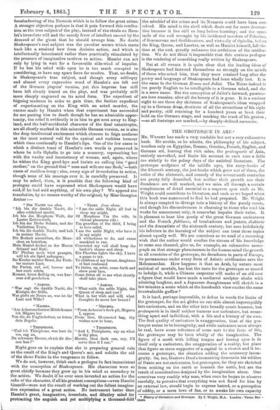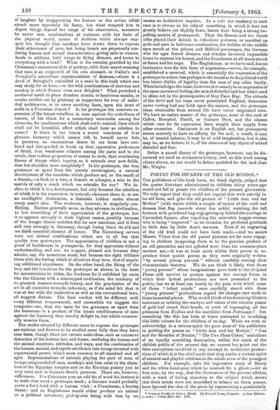THE GROTESQUE IN ART.*
Mn. WRIGHT has made a very readable but not a very exhaustive book. He avoids, as he admits, the philosophy of his subject, touches only on Egyptian, Roman, Grecian, French, English, and German art, leaving that rich mine, the grotesquerie of Asia, entirely unworked, and limits his account in each case a little too strictly to the palmy days of the satirical literature. The grotesque sculpture of the middle ages, the story-books of the fifteenth century, the jest-books which grew out of them, the satire of the sixteenth, and comedy of the seventeenth centuries are pretty fully described, but neither their growth nor their
decadence are well marked, and we miss all through a certain completeness of detail essential to a magnum opus such as Mr. Wright could contribute to literature, and such as we hoped when this book was announced to find he had prepared. Mr. Wright is always tempted to diverge into a history of the purely comic, and though his discursiveness is charming to those who read his works for amusement only, it somewhat impairs their value. It is pleasant to hear him gossip of the great German caricatures and the French fabliaux, of troubadours and jesters, diablerie and the dramatists of the sixteenth century, but men indefinitely his inferiors in the learning of the subject can treat those topics almost equally well. We are conscious as we read of a recurring wish that the author would confine the stream of his knowledge to some one channel, give us, for example, an exhaustive mono- graph on that strange phenomenon in the human mind the growth in all countries of the grotesque, its decadence in parts of Europe, its permanence under every form of Asiatic civilization save the Mahommedan. How happens it that an Arab, by nature most satirical of mortals, has lost the taste for the grotesque or ceased to indulge it, while a Chinese carpenter will make of an old root a figure that would have made a mediaeval sculptor shake with admiring laughter, and a Japanese draughtsman will sketch iu few minutes a scene which at the hundredth view excites the same irrestrainable guffaw?
It is hard, perhaps impossible, to define in words the limits of the grotesque, for the art glides on one side almost imperceptibly into caricature, and on the other into broadly comic humour, but grotesquerie is in itself neither humour nor caricature, but some- thing apart and individual, with a life and a history of its own. The first quality of caricature is exaggeration, that of the gro- tesque seems to be incongruity, and while caricature must always be real, have some reference of some sort to the facts of life, the grotesque may be born wholly of the imagination. The figure of a monk with lolling tongue and leering eyes is in itself only a caricature, the exaggeration of a reality, but place that figure as stone supporter of a capital in a church and it be- comes a grotesque, the situation adding the necessary incon- gruity. So, too, Gustave Dore's tormenting demons in his edition of Dante are not caricatures, but grotesques, for they are sketched from nothing on the earth or beneath the earth, but are the result of combinations designed by the imagination alone. One conceives very readily why man, when once be began to observe carefully, to perceive that everything was not fixed for him by an external law, should begin to express hatred, or a perception of oddity, or a mere love of fun, or to awake his own capacity
* History of Caricature and Grotesque. By T. Wright, M.A. London : Virtue Bro them. of laughter by exaggerating the feature or the action which struck more especially his fancy, but what tempted him to depict things beyond the range of his observation, monsters he never saw, combinations at variance with the facts of the physical world, scenes of diablerie which always sug- gest the thought that monkeys have drawn them to express their abhorrence of men, but being beasts are perpetually con- fusing human and animal characteristics, giving tails to women, hoofs to athletes, bats' wings to flying demons, and horns to everything with a bead ? What is the emotion gratified by the Chinaman's monstrous idols of pottery, with their secret meaning that man is an outgrowth of his own stomach, or Callot's and Breughel's marvellous representations of demons,—there is a devil of Breughel's embodied in a snail in this book which one may study for an hour,—or the wild combinations of skeleton and monkey in which France even now delights ? What provoked a mediaeval monk to place drunken monks, or lascivious monks, or monks swollen out by gluttony as supporters for ever of cathe- dral architraves, or to carve mocking faces, upon the arms of stalls in a Christian church ? Is the grotesque the concrete ex- pression of the latent rebellion in man against the orderliness of nature, of his thirst for a momentary saturnalia among the elements, for combinations which shall not be natural, lines which shall not be beautiful, effect which shall have no relation to cause ? Is there in our hearts a secret weariness of that glorious harmony which nature left to herself never fails to preserve, an unconscious desire to see those laws con- fused and disregarded, to break up that :oppressive perfectness of detail, that wearisome relation among the parts and to the whole, that tedious proportion of means to ends, that everlasting fitness of things which inquiry, as it extends over new fields, does but elucidate more completely ? Is the grotesque, the true grotesque as apart from the merely extravagant, a natural development of the emotions which produce art, or the result of a disease,—a limb or a wen, a branch or a fungus, a vein in the marble or only a crack which we mistake for one ? We in- cline to think it is a development, but only because the rebellion of which it is the expression is natural,—because there is, to use an intelligible illustration, a Rabelais hidden under almost every man's skin. The evidence, however, is singularly con- flicting. Nations generally seem, as they advance in civilization, to lose something of their appreciation of the grotesque, but it re-appears strongly in their highest castes, possibly because of the hunger blasee,s societies feel for new emotions, and it lives still very strongly in Germany, though losing there its old and we think essential element of horror. The Nuremburg carvers turn out animal combinations which are in all but that quality true grotesques. The appreciation of children is not a proof of healthiness in grotesquerie, for they appreciate without understanding, and are, we suspect, pleased not because they admire, say, the monstrous mask, but because the sight titillates thorn with the feeling which of all others they love, that of acquir- ing additional experience. On the other hand, the liking of the lazy and the luxurious for the grotesque as shown in the taste for monstrosities in china, the fondness for it exhibited by races like the Chinese with a stereotyped civilization, the tendency of its greatest masters towards lunacy, and the gravitation of the art in all countries towards indecency, as if the mind felt that it was at war with the instinctive as well as the conventional laws, all suggest disease. The final verdict will be different with every different temperament, and meanwhile we suggest the composite one, that the taste for the grotesque as apart from the humorous is a product of the latent rebelliousness of men against the harmony they usually delight in, but which occasion- ally wearies them.
The modes adopted by different races to express the grotesque are curious, and deserve to be studied more fully than they have ever been, though there are certain main ideas, such as excessive distortion of the human face and frame, confusing the human and the animal emotions, attitudes, and ways, and the combination of the human, animal, and reptile attributes into beings invested with supernatural power, which seem common to all mankind and all ages. Representations of animals playing the part of men, of beings compounded of men, monkeys, and bats exist in the cham- bers of the Egyptian temples and on the Etrurian pottery just as they exist now in Gustave Dore's pictures. There are, however, differences. If a Chinaman sees an odd bit of wood his instinct is to make that wood a grotesque mask ; a German would probably carve a fox's head with a human wink ; a Frenchman, a leering Satan ; and an Englishman would either produce an animal or a political caricature, grot:sq•lerie being with him by no means an instinctive impulse. As a rule the tendency in each race is to choose as its subject something in which it does not greatly believe yet slightly fears, latent hate being a strong im- pelling motive of grotesquerie. Thus the Roman and the Greek alike placed their deities in ridiculous postures, or muddled up gods and men in ludicrous combination, the builder of the middle ages struck at the priests and Biblical personages, the German who for ages feared demons and witches invented impossible forms to express his horror, and the Frenchman at all times struck at Satan and his imps. The Englishman, as we have said, has no instinctive love for this form of expression,—never, for example, established a carnival, which is essentially the expression of the grotesque in action, has perhaps in the moral as in the political world less latent dislike of legality than the man of any other family. When he i ndulges the taste, however, it is usually in an expression of the same current of feeling, the mixed disbelief and fear which used to shine out in the grotesqueries of Guy Faux Day. The ridicule of the devil and his imps never penetrated England, demonism never having had any hold upon the masses, and the grotesque ideas obtainable from animal life have never originated here. We have no native master of the grotesque, none of the rank of Callot, Breughel, Fuseli, or Gustave Dore, and the classes which care for its expression have sought their supply from other countries. Caricature is an English art, but grotesquerie seems scarcely to have an affinity for the soil, a result, it may be, of mental balance, it may be of cold imagination, but it also may be, as we believe it iv, of the absence of any object of mixed disbelief and fear.
Before a sound theory of the grotesque, however, can be dis- covered we need an exhaustive history, and, as this work among others shows, no one would be better qualified for the task than Mr. Wright.































 Previous page
Previous page